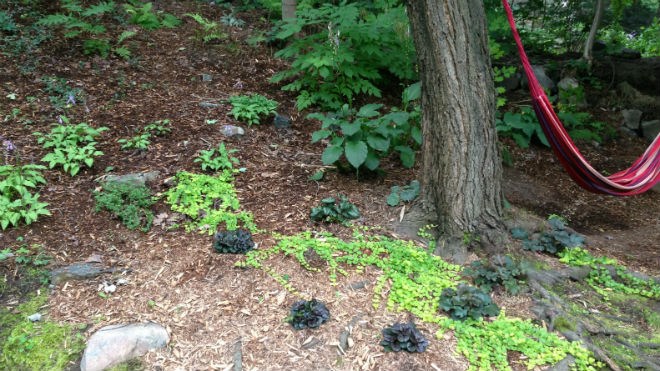I have come to dote on my shade garden like a mother to her child. And its responsiveness to my attention is nothing short of thrilling.
A forgotten slope it was when we first moved in — unforgivably dry in parts, impossibly muddy in others; yet all over, knee-deep in weeds and vine.
There’s nothing I like more than a challenge.
Since that time, four years ago, I have come to spend a lot of time and energy back there in the deep shade, mosquitos and slugs be damned. I’ve come to see it not as a challenge, but as a gift. For I have learned that nature has evolved some gorgeous deep-shade loving plants blessed with stunning foliage.
Not all shade plants are measured the same. Some are drought tolerant and others moisture hungry. I happen to have both types of conditions, yet have been working hard to amend the soils with mulches, composts and other humus-rich materials.
For the longest time, I wouldn’t dare plant a fern, but with this aforementioned doting, I have been able to sustain a whole variety of them.
If you’ve got trees, which, let’s face it, is the primary reason there’s so much darkness and dappled light (unless we’re talking about the north side of a house), then you’ve got to take some measures with what you plant, since Norway maples and most evergreens are greedy moisture-suckers.
Plant the following shade lovers:
Lily of the Valley: With perfumed white flowers and the spreading facility of a common cold, this otherwise toxic plant (if ingested) is stunning and easy to grow. I’ve got it everywhere.
St. John’s Wort: Grow this medicinal herb with charming yellow flowers and you’ve got the makings for a anxiety/depression battling tincture. If you want a recipe, send me an email.
English Ivy: Often variegated and always glossy and deep green, this vine recalls the grand homes of Old England. And covers the side of your shed.
Periwinkle: I planted so much of this groundcover it’s starting to knit together like a carpet, with the added bonus of charming purple flowers come spring. Did I mention they’re also evergreen? Green goodness all year long.
Japanese Sedge: Super shiny and robust, this groundcover shoots up like an umbrella. I imagine snails and beetles cavorting underneath.
Got moisture?
If you’ve got moisture, then go for the following:
Creeping Jenny: In my shade garden, I’m going for a lime green, deep shades of purple vibe. This creeper take care of the lime department.
Ferns: Sensitive, Crested, Ostrich, Japanese — you name it, try growing it.
Hostas: Without question. I like variegated to break up the monotony of green.
Lungwort: Horrendous name, but this low-growing plant has beautiful polka-dot foliage. I grow it around the base of my ferns.
Bugleweed: With shiny burgundy foliage, spears of purple flowers and great spreading capacity, this ground-cover gives me that contrast I’m looking for.
The list goes on: Astilbe, Wild Ginger, Foamflower, Coral Bells, Primrose. Not all plants are meant to be scorched by the mid-afternoon sun.
Anne Boulton is an avid gardener who lives in Sudbury. Visit her blog at greenboots.ca or contact her at [email protected].
